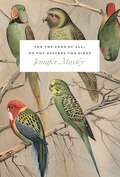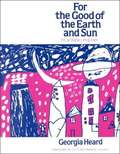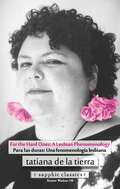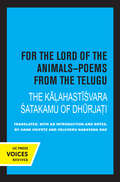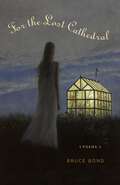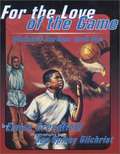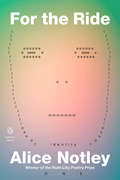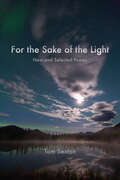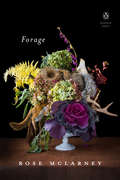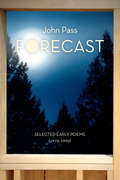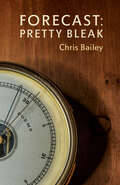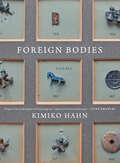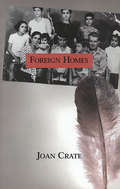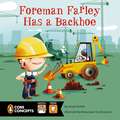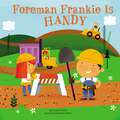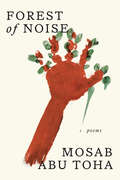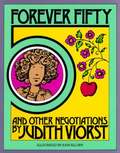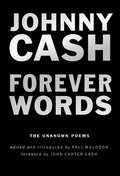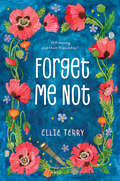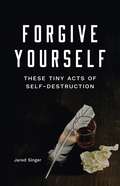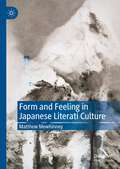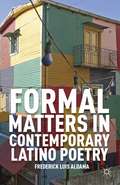- Table View
- List View
For the Good of All, Do Not Destroy the Birds: Essays
by Jennifer MoxleyIn this collection of essays, the author draws upon a wide range of sources, from Greek mythology and modern poetry to her personal experiences with pigeons and parakeets. Birds and their symbolism in art and literature are featured in each essay.
For the Good of the Earth and Sun: Teaching Poetry
by Georgia Heard Lucy Mccormick-CalkinsThe principles of teaching poetry discussed are applicable to any classroom of student poets, regardless of age.
For the Hard Ones/Para las duras (Sapphic Classic)
by tatiana de la tierraPara las duras: Una fenomonologia lesbiana / For the Hard Ones: A Lesbian Phenomenology, originally published in 2002, is a collection of poetry existing from and beyond the boundaries of language, sexuality, and genre. Each memory, meditation, analysis, and erotic snapshot— featured side-by-side in both English and Spanish— is overlaid with the sexual character, experimental prose, and levity signature to the work of de la tierra. As a bilingual book, For the Hard Ones: A Lesbian Phenomenology / Para las duras: Una fenomonologia lesbiana centers, explores, and reimagines queer Latina sexuality, opening up space for multiple interpretations and transformations. This new edition, published as the sixth Sapphic Classic from Sinister Wisdom, features an introduction by scholars Olga García Echeverría and Maylei Blackwell, a foreword by Myriam Gurba, an essay on de la tierra's periodicals by Sara Gregory, and a tribute to de la tierra by her mother, proving a vibrant context for contemporary engagements with de la tierra's powerful and important work.
For the Lord of the Animals-Poems from The Telugu: The Kalahastisvara Satakamu of Dhurjati
by Velcheru Narayana Rao Hank HeifetzThis title is part of UC Press's Voices Revived program, which commemorates University of California Press’s mission to seek out and cultivate the brightest minds and give them voice, reach, and impact. Drawing on a backlist dating to 1893, Voices Revived makes high-quality, peer-reviewed scholarship accessible once again using print-on-demand technology. This title was originally published in 1987.
For the Lost Cathedral: Poems
by Bruce BondFor the Lost Cathedral delves deeply into the human relationship with the divine and its capacity for empathy, transformation, and the tolerance of difference and doubt. Bruce Bond seeks neither to praise nor to attack institutional religions, instead choosing to explore their interactions with the inner lives of those who hold them sacred. Faith can offer comfort and security in difficult times, yet it may also create the temptation to hold to absolutes. For the Lost Cathedral examines the tensions inherent in spiritual devotion as well as the impact of such devotion on our most defining conflicts, creativities, and acts of sacrifice. In poems whose formal simplicity belies the depth of their complexity and insight, Bond explores a dialogue between the spiritual and the religious. A tour de force of emotional truth and focus, For the Lost Cathedral embodies a spirit of wonder in the face of difficulties that might otherwise appear intractable.
For the Love of the Game: Michael Jordan and Me
by Eloise Greenfield Jan Spivey GilchristThis inspiring poem encourages children to view life with the same determination and passion that Michael Jordan displays in how he plays basketball. By listening to their inner voice and looking to those who love and support them, children can find their own way to fly. Distinguished poet Eloise Greenfield and celebrated artist Jan Spivey Gilchrist honor the beauty of the human spirit and offer a timeless message that will resonate with readers young and old.
For the Ride (Penguin Poets)
by Alice NotleyA major new book-length visionary poem from a writer "whose poems are among the major astonishments of contemporary poetry" (Robert Polito, the Poetry Foundation)Alice Notley has become one of the most highly regarded figures in American poetry, a master of the visionary mode acclaimed for genre-bending, book-length poems of great ambition and adventurousness. Her newest book, For the Ride, is another such work. The protagonist, "One," is suddenly within the glyph, whose walls project scenes One can enter, and One does so. Other beings begin to materialize, and it seems like they (and One) are all survivors of a global disaster. They board a ship to flee to another dimension; they decide what they must save on this Ark are words, and they gather together as many as are deemed fit to save. They "sail" and meanwhile begin to change the language they are speaking, before disembarking at an abandoned future city.
For the Sake of the Light: New and Selected Poems (Alaska Writer Laureate)
by Tom SextonThis collection of new and selected poems by the former poet laureate of Alaska, Tom Sexton, opens a door on the essence of life in Alaska and Maine. Sexton divides his year between the two states, and he captures here the small but powerful sensual details of day-to-day life in these contrasting, yet similar, environs. His carefully crafted verse distills the birch and aspen, lynx and ptarmigan, and the snow on high peaks. Through his poems we thrill to experience encounters with the wild, the seasons, and the sublime landscape. “His language is clear, without tricks or fancy moves, yet his directness is powerful, and the effects are human”—Paul Zimmer, Georgia Review
Forage (Penguin Poets)
by Rose McLarneyA poet acclaimed for "uncompromising, honest poems that sound like no one else" (The Rumpus) now offers considerations of the natural world and humans' place within it in ecopoetry of both ambitious reach and elegant refinementRose McLarney has won attention as a poet of impressive insight, craft, and a "constantly questioning and enlarging vision" (Andrew Hudgins). In her third collection, Forage, she continues to weave together themes she loves: home, heritage, the South, animals, water, the environment. These intricately sequenced poems take up everything from animals' symbolic roles in art and as indicators of ecological change to how water can represent a large, troubled system or the exceptions of smaller, purer tributaries. At the confluence of these poems is a social commentary that goes beyond lamenting environmental degradation and disaster to record--and augment--the beauty of the world in which we live.
Forcierte Form: Deutschsprachige Versepik des 20. und 21. Jahrhunderts im europäischen Kontext (Abhandlungen zur Literaturwissenschaft)
by Kai Bremer Stefan ElitDas Versepos, einst bedeutend unter den literarischen Gattungen und mit einer reichen Tradition seit der Antike, ist im deutschsprachigen wie im europäischen Raum seit etlichen Jahrzehnten deutlich weniger im Fokus. Immer wieder totgesagt, ist es jedoch lebendiger als vermutet. Versepen werden weiterhin verfasst, und zwar zu unterschiedlichsten Themen und Zwecken als eine besonders forcierte Form im Rekurs auf die Traditionen der Gattung. Der vorliegende Band rekapituliert zentrale Traditionslinien und analysiert dann in exemplarischer Absicht deutschsprachige Versepen der literarischen Moderne und der Nachkriegszeit bis in die Gegenwart sowie angrenzende Beispiele in italienischer, russischer und englischer Sprache.
Forecast
by John PassForecast recovers early out-of-print work by Governor General's Award-winning poet John Pass. The poems engage potentialities--travel, an orchard he cares for, evolving relationships, house-building, becoming a poet and husband and father. They're grounded in place and time, but attuned, as he says, to constancy. Those for his young sons are poignant with the perilous hope of new parenthood: "asking courage of me / as never I needed nor knew it in sorrow." Darker premonitions--dislocation, environmental damage, poetry's shift from modernism to postmodernism--are mitigated throughout by the subtlety and solace of attentive expression. In "Apple," Pass "contrives" to suspend time so that "Friends in the kitchen / re-reading Pound's translations / of Rihaku" are still there days later when the tree outside blooms, concluding: "Only beyond / in the garden, that canopy // of fragrance, art's / complement: coincidence. // Friends, come home. / There is everything." Any fashionable irony is tempered--dispirited and optimistic. In "An Arbitrary Dictionary," random words are selected to become poem titles, idiosyncratic definitions. Surprising complexity and insight often spring from their funny and irreverent first takes, as in "Tuck": "No life for a fat man / with that once merry band gone wan / on a diet of personal aggrandizement / and Perrier." The sequence's experimentation foreshadows Pass's expansive work in his later quartet, AT LARGE.
Forecast: Poems
by Chris Bailey&“This is no quaint voice from the Land of Anne. Suffused with our era&’s geist and angst, which have penetrated to the rural periphery, Bailey is a sharp-eyed, clarion-voiced witness.&” —Richard LemmConfessional, candid, and insightful, Forecast: Pretty Bleak looks at life in rural PEI. These poems explore climate change, work, family, love, and the idea that sometimes all you&’ve got is hope for better weather and favourable winds tomorrow.
Foreign Bodies: Poems
by Kimiko HahnA striking, shapeshifting volume from "one of the most fascinating female poets of our time (BOMB)." Inspired by her encounter with Dr. Chevalier Jackson’s collection of ingested curiosities at Philadelphia’s Mütter Museum, Kimiko Hahn’s tenth collection investigates the grip that seemingly insignificant objects exert on our lives. Itself a cabinet of curiosities, the collection provokes the same surprise, wonder, and pangs of recognition Hahn felt upon opening drawer after drawer of these swallowed, and retrieved, objects—a radiator key, a child’s perfect attendance pin, a mother-of-pearl button. The speaker of these moving poems sees reflections of these items in the heartbreaking detritus of her family home, and in her long-dead mother’s Japanese jewelry. As Hahn remakes the lyric sequence in chains reminiscent of the Japanese tanka, the foreign bodies of the title expand to include the immigrant woman’s trafficked body, fossilized remains, a grandmother’s Japanese body. She explores the relationship between our innermost selves and the relics of our vanished past, making room for meditation on grief and the ephemeral nature of the material world, for the account of a nineteenth-century female fossil hunter, and for a celebration of the nautilus. Foreign Bodies investigates the power of possession, replete with Hahn’s electric originality and thrilling mastery of ever-changing forms.
Foreign Homes
by Joan CrateShortlisted for the 2002 Pat Lowther Award Foreign Homes, Joan Crate's second book of poems, explores domesticity and dislocation, where what was thought to be home becomes alien, and where the alien is, piece by piece, made into home -- often in such simple, physical acts as laying a table, or driving a highway, or reassembling a torn photograph. In Crate's careful hands, the knife that cuts the vegetables for dinner can transform the blade-edge of a distant war. Her migratory poems slip from voice to voice, from love to landscape to language, present to past, exile to return, illuminating the boundary that is also a border crossing between one person, one place, and another. Domestic images and personal narrative surround a burning, incantatory sequence at the centre of the book, where poems circle Shawnandithit, a Beothuk who died in exile in Newfoundland in the nineteenth century, the last of her people. In giving voice to what is unknown, feared, lost, and silent, Crate’s playful language is itself powerfully involved in this act-often violent-of breaking and making anew. And whether these homes are stolen or lost or stumblingly found, Crate is unflinching even as her own homes are made and un-made, watching those "who wait on the porch steps/ eager to move into our youth,/ to reassemble our bones."
Foreman Farley Has a Backhoe (Penguin Core Concepts)
by Jenny GoebelForeman Farley has to build a new school. What does he need? A crane, a bulldozer, a dump truck, and more! Can he get the job done?Foreman Farley Has a Backhoe covers the concepts Community Workers & Helpers and Problem Solving.
Foreman Frankie Is Handy
by Jenny GoebelForeman Frankie is paving a new highway. To do so, Foreman Frankie and his crew need to mix concrete, pour a layer of asphalt, and make sure the road is very smooth. Sing along to the tune of &“Yankee Doodle Went to Town&” and see how quickly Foreman Frankie and his crew can pave the highway!
Forest of Noise: Poems
by Mosab Abu TohaA NEW YORK TIMES NOTABLE BOOK • "A powerful, capacious, and profound" (Ocean Vuong) new collection of poems about life in Gaza by an acclaimed Palestinian poet and Pulitzer Prize-winning writerYou are alivefor a momentwhen living peoplerun after you.Barely thirty years old, Mosab Abu Toha was already a well-known poet when the current siege of Gaza began. After the Israeli army bombed and destroyed his house, pulverizing a library he had painstakingly built for community use, he and his family fled for their safety. Not for the first time in their lives. Somehow, amid the chaos, Abu Toha kept writing poems. These are those poems. Uncannily clear, direct, and beautifully tuned, they form one of the most astonishing works of art wrested from wartime. Here are directives for what to do in an air raid; here are lyrics about the poet&’s wife, singing to his children to distract them. Huddled in the dark, Abu Toha remembers his grandfather&’s oranges, his daughter&’s joy in eating them. Moving between glimpses of life in relative peacetime and absurdist poems about surviving in a barely livable occupation, Forest of Noise invites a wide audience into an experience that defies the imagination—even as it is watched live. Abu Toha's poems introduce readers to his extended family, some of them no longer with us. This is an urgent, extraordinary, and arrestingly whimsical book. Searing and beautiful, it brings us indelible art in a time of terrible suffering.
Forever Fifty and Other Negotiations
by Judith ViorstA charming book of poetry about getting older in this modern age. Viorst's humor is the deft answer to the stress of becoming "over fifty".
Forever Words: The Unknown Poems
by Johnny CashA collection of never-before-published poems by Johnny Cash, edited and introduced by Pulitzer-prize winning poet Paul Muldoon with a foreword by John Carter Cash. Illustrated with facsimile reproductions of Cash's own handwritten pages.Since his first recordings in 1955, Johnny Cash was an icon in the music world. In this collection of poems and song lyrics that have never been published before, we see the world through his eyes and view his reflection on his own interior reality, his frailties and his strengths alike. In his hallmark voice, he pens verses about love, pain, freedom, and mortality, and expresses insights on culture, his family, his fame, even Christmas. Forever Words confirms Johnny Cash as a brilliant and singular American literary figure. His music is a part of our collective history, and here the depth of his artistry and talent become even more evident.From the Hardcover edition.
Forever: Poems
by James LongenbachIn lucid, elegant poems, Forever contemplates love against the pressing question of mortality after a diagnosis of cancer. Praised for a voice with "the crystalline, transformative, pure pitch of a lyric poet" (Ilya Kaminsky), James Longenbach explores a life lived with the knowledge of its end in his sixth collection. These luminous, lyrical poems pose a question: Why did this poet once live as if he would live forever? And what does it mean to know that we will not? Forever explores the meaning of love, from its discovery in the first poem, "Two People," to its maintenance in the last, "Forever." In between, the volume explores the precariously imminent demise of all that we love?the finite lives of other people, the mortal beauty of Venice—all thrown into urgent relief by the poet’s own cancer diagnosis. Evoking "the vivid dailiness of domestic life…and the specificity and poignance" of memories, "these lyrics are intimately personal, achingly autobiographical" (Langdon Hammer, American Scholar). Forthright, moving, and wry, the poems in Forever look back gratefully—excitedly—on a lifetime of self-making and self-shattering events.
Forget Me Not
by Ellie TerryAstronomy-loving Calliope June has Tourette syndrome, so she sometimes makes faces or noises that she doesn't mean to make. When she and her mother move yet again, she tries to hide her TS. But it isn't long before the kids at her new school realize she's different. Only Calliope's neighbor, who is also the popular student body president, sees her as she truly is--an interesting person and a good friend. But is he brave enough to take their friendship public? As Calliope navigates school, she must also face her mother's new relationship and the fact that they might be moving--again--just as she starts to make friends and finally accept her differences. Ellie Terry's affecting debut will speak to a wide audience about being true to oneself.
Forgive Me, I Meant to Do It
by Gail Carson LevineThis Is Just to Say If youâ#128;#153;re looking for a nice happy book put this one down and run away quickly Forgive me sweetness and good cheer are boring Inspired by William Carlos Williamsâ#128;#153;s famous poem â#128;#157;This Is Just to Say,â#128;#157; Newbery Honor author Gail Carson Levine delivers a wickedly funny collection of her own false apology poems, imagining how tricksters really feel about the mischief they make. Matthew Cordellâ#128;#153;s clever and playful line art lightheartedly captures the spirit of the poetry. This is the perfect book for anyone whoâ#128;#153;s ever apologized . . . and not really meant it.
Forgive Yourself These Tiny Acts Of Self-Destruction (Button Poetry)
by Jared SingerSinger's highly anticipated debut book collects and transforms work from his ten years as a mainstay of the NYC poetry scene. With work that ranges from the laugh out loud funny to the silence and rage of loss, Forgive Yourself These Tiny Acts of Self-Destruction is a must read. As the book unfolds Jared guides the reader through fresh takes on the discussion of body image and body positivity side by side with all too familiar discussions of mental health, anxiety and suicide. It explores the complex cloth that is American culture and New York in particular, taking extra time to examine his identity as a Jewish American and how that underpins the authors daily experience. Forgive Yourself is a modern handbook for finding yourself and your place without losing your way.
Form and Feeling in Japanese Literati Culture
by Matthew MewhinneyThis book explores how two early modern and two modern Japanese writers – Yosa Buson (1716–83), Ema Saikō (1787–1861), Masaoka Shiki (1867–1902), and Natsume Sōseki (1867–1916) – experimented with the poetic artifice afforded by the East Asian literati (bunjin) tradition, a repertoire of Chinese and Japanese poetry and painting. Their experiments generated a poetics of irony that transformed the lineaments of lyric expression in literati culture and advanced the emergence of modern prose poetry in Japanese literature. Through rigorous close readings, this study changes our understanding of the relationship between lyric form and the representation of self, sense, and feeling in Japanese poetic writing from the late eighteenth through the early twentieth century. The book aims to reach a broad audience, including specialists in East Asian Studies, Anglophone literary studies, and Comparative Literature.
Formal Matters in Contemporary Latino Poetry
by Frederick Luis AldamaToday's Latino poetry scene is incredibly vibrant. With original interviews, this is the first meditation on the thematic features of such poetry. Looking at how Julia Alvarez, Rhina Espaillat, Rafael Campo, and C. Dale Young use structures such as meter, rhyme, and line break, this study identifies a poetics of formalist Latino poetry.
